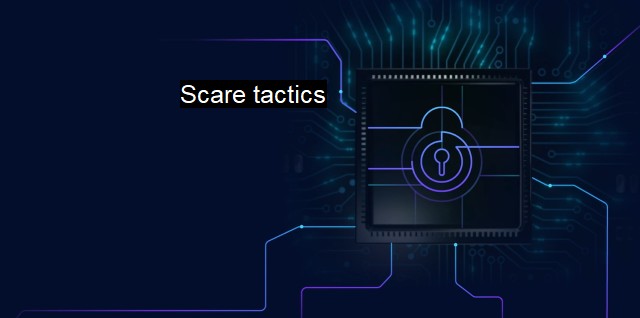What are Scare tactics?
The Ethics and Effectiveness of Scare Tactics in Cybersecurity: An Analysis of the Strategies Employed by Antivirus Companies
Scare tactics are ways of frightening people into taking a certain action or behavior. A prevalent use of scare tactics is in marketing, where companies use these techniques to pressure and scare consumers into buying their products, believing they are essential for their safety, well-being, or security. This strategy is especially notable in the context of cybersecurity and antivirus systems where messages could be incredibly alarming to a layperson unfamiliar with computer networks and security.Scare tactics in cybersecurity involve the intentional use of frightening security scenarios to create a heightened sense of fear and panic. It's a psychological tool employed to manipulate individuals or organizations into behaving in a manner that is advantageous to the manipulator. For instance, a cybersecurity company might emphasize the imminent danger of devastating ransomware attacks and describe how they can cripple business operations, leading organizations to quickly procure their services out of fear.
More ominously, scare tactics are often used in the actual execution of cyber attacks. Phishing emails often use scare tactics to compel victims to comply with their fraudulent requests. These emails may send alarming warnings about account security breaches, creating panic and leading individuals to impulsively provide sensitive financial or personal information to "secure" their accounts. These provided credentials are then exploited by hackers for illegal purposes.
Similarly, malicious pop-ups warning users of the presence of a "terrible virus" that could "immediately and fatally damage" a computer are another application of scare tactics. These notifications are intended to convince users to download a supposed antivirus program, which is in reality malware—a self-fulfilling prophesy, of sorts.
Despite the frightful and manipulative nature of scare tactics, the complicated reality is that cyber threats are a significant issue. Data breaches, ransomware attacks, and identity theft are rampant in the digital age, with millions of these incidents occurring globally each year. Consequently, organizations need robust cybersecurity measures, while individuals must be well versed in the basics of online and computer safety. After all, scare tactics are the most effective once target vulnerabilities and a lack of awareness are combined.
Yet, the use of scare tactics can also lead to fear fatigue, where people are so overwhelmed with constant scary messages that they start ignoring these warnings, becoming paradoxically more susceptible to actual threats. Strategic caution is needed to balancing the realistic dangers and the use of scare tactics, avoiding unnecessary panic while keeping everyone updated on authentic threats.
Therefore, proficiency and a little skepticism can go a long way to counteract scare tactics in this heightened digital era. A resilient cybersecurity infrastructure built on educated users equipped with reliable antivirus software can fend off most of the attacks. Similarly, critical email scrutiny, secure password routines, and a steadfast grasp on what to click or to share, can maintain robust cybersecurity. Individuals and businesses should also review and discern scare tactic-fueled messages about looming security threats that aim to incite urgency and fear—a sort of "cyber-panic defense."
Scare tactics in the field of cybersecurity and antivirus systems are deliberately inciting strategies intended to manipulate through fear. Be it be commercial enterprises pressuring customers into buying their products or cybercriminals coaxing potential victims into sharing their sensitive information, scare tactics function on the premise of fear. Regardless of its applications, various measures such as education, critical thinking, and consistent safety practices can provide reliable defense against scare tactics in cybersecurity.

Scare tactics FAQs
What is scareware?
Scareware refers to a type of malicious software that is designed to deceive users into thinking that their computer is at risk or infected with viruses. It uses scare tactics to trick people into paying for unnecessary software or services.How does scareware work?
Scareware typically presents false warnings or pop-up messages to the user, claiming that their computer has been infected or is vulnerable to attack. The message may encourage the user to download and install antivirus software or to provide personal information. In reality, the software or service being offered is often useless or even harmful.How can I protect myself from scareware?
To protect yourself from scareware, it is essential to use reputable antivirus software and to keep it up-to-date. Avoid downloading software or clicking on pop-up messages from unknown sources. Be wary of any unsolicited communication that asks for personal or financial information.What should I do if I think my computer has been infected with scareware?
If you suspect that your computer has been infected with scareware, the best course of action is to run a full virus scan using your antivirus software. If the scan detects any threats, follow the instructions to remove them. If you have already paid for a scam antivirus product, immediately contact your bank or credit card company to dispute the charge and report the fraudulent activity.| | A | | | B | | | C | | | D | | | E | | | F | | | G | | | H | | | I | | | J | | | K | | | L | | | M | |
| | N | | | O | | | P | | | Q | | | R | | | S | | | T | | | U | | | V | | | W | | | X | | | Y | | | Z | |
| | 1 | | | 2 | | | 3 | | | 4 | | | 7 | | | 8 | | |||||||